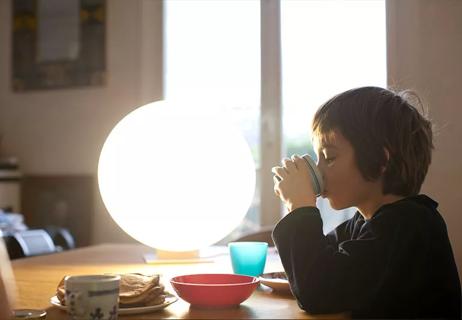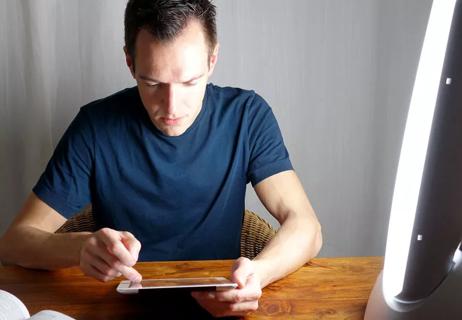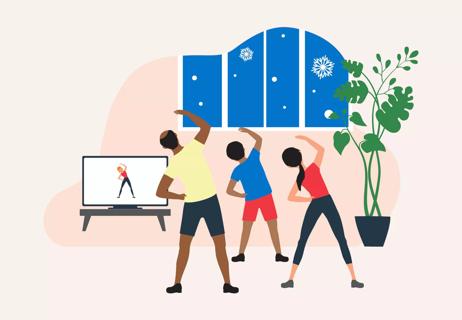Helpful tips to ward off the winter blues

Do you find yourself struggling with those cold, dreary days of fall and winter? It’s normal to feel a little down if you live for the warm-weather months. But if you routinely feel sad for no reason, have trouble sleeping and spend most of your days on the couch eating comfort food and binge-watching your favorite shows, you might be experiencing seasonal affective disorder (SAD).
Advertisement
Cleveland Clinic is a non-profit academic medical center. Advertising on our site helps support our mission. We do not endorse non-Cleveland Clinic products or services. Policy
SAD, also called seasonal depression, is a form of depression that is usually experienced during the late fall when there is less sunlight and the days are shorter and colder. Seasonal depression can also happen in the summer, but it’s much less common.
While millions of people live with SAD, women are more likely to experience it than men. SAD is also more commonly experienced in cloudy parts of the country or areas that are farther away from the equator.
You might just think that you’re in a funk and can shake it off. But with SAD, it can go much deeper. Symptoms may include:
Symptoms of SAD tend to pop up later in the fall or early in the winter and they tend to subside during the warmer months.
If you’re trying to loosen SAD’s grip naturally, psychologist Scott Bea, PsyD, offers some helpful suggestions for managing it.
Most people spend less time outside and as a result, their levels of physical activity decrease. However, if you think you might be experiencing SAD, exercise could be a good way to combat it.
Advertisement
“Moving your body will compete with that tendency to be sluggish and can produce good brain chemistry,” says Dr. Bea.
Consider indoor activities that you’d enjoy. You might try yoga or running on a treadmill. If you’re feeling more adventurous and want to brave the elements, go skiing or snowshoeing to make the most of the cold weather.
The colder months tend to increase our urge to hunker down and stay home — which then results in much less social interaction. If this sounds like you, Dr. Bea recommends connecting with others regularly. Social interaction can help lift your spirits. It can also help you get out of your head.
“Creating a new social obligation can motivate us. Anything that makes you take part in activities that allow you to be engaged outside of your self-awareness is useful for people who are living with SAD.”
Experts believe SAD is triggered by changes in our exposure to sunlight. A recent study showed that bright light therapy could be an effective treatment for SAD, but larger studies still need to be done regarding this option.
Light therapy is administered by a device that contains white fluorescent light tubes covered with a plastic screen that blocks ultraviolet rays. Light therapy boxes range in intensity, up to 10,000 lux of light. According to Dr. Bea, many health professionals recommend treating SAD by sitting in front of 10,000 lux light for 30 minutes every morning. While it’s generally safe and well-tolerated by most people, those with certain health conditions shouldn’t try it.
“Light therapy is not appropriate for those with conditions such as diabetes or people with retinal damage because it could make those conditions worse.”
Dr. Bea also recommends eating a well-balanced diet, which includes sufficient amounts of vitamins and minerals.
“Healthy eating will help you have more energy even though your body might be craving those starchy foods and sweets.”
If the depression sticks around for more than two weeks, talk with your doctor. Medication or psychotherapy may also help.
According to the National Institute of Mental Health, to be diagnosed with SAD, the following criteria have to be met:
If these statements apply to you, your healthcare provider or a mental health professional can develop a treatment plan to help you beat seasonal depression.
Advertisement
Learn more about our editorial process.
Advertisement

If you experience warm weather seasonal depression, you’re not alone

Cozying up with friends and family can make cold, dark days more meaningful

An expert explains how seasonal weather changes affect our health

We shine a light on how light therapy can improve your mood

Light therapy can boost sleep and help fight depression

Plus, helpful tips for managing SAD during these challenging times

Step back from social media, set boundaries and spot the symptoms of SAD

Most recommended precautions center around minimizing bruising or swelling

Type 2 diabetes isn’t inevitable with these dietary changes

Applying a hot or cold compress can help with pain